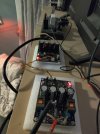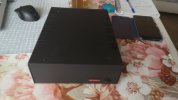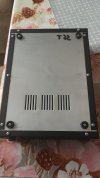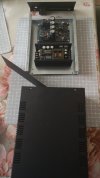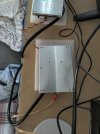-
WANTED: Happy members who like to discuss audio and other topics related to our interest. Desire to learn and share knowledge of science required. There are many reviews of audio hardware and expert members to help answer your questions. Click here to have your audio equipment measured for free!
- Forums
- Audio, Audio, Audio!
- Amplifiers, Phono preamp, and Analog Audio Review
- Stereo and Multichannel Amplifier Reviews
You are using an out of date browser. It may not display this or other websites correctly.
You should upgrade or use an alternative browser.
You should upgrade or use an alternative browser.
3e Audio TPA3255 Amplifier Kit 480-1-29A Review
- Thread starter amirm
- Start date
Tell
Senior Member
- Joined
- Mar 30, 2024
- Messages
- 366
- Likes
- 525
Shit happensI think I mixed it up in my head.
Hi Amigos
want to share some info on Rev B released recently:

share a test between OPA1612 and OPA1656

want to share some info on Rev B released recently:
- Input Opamp Change to OPA1556,this is due to part unified that we found it perform the same as OPA1612 in another project.
- add a optional 12V connector (not populated) for some people that need for power LEDs,etc.
- Buck cap change to 1500uF/80V/Nichicon due to 1800uF/63V/Rubycon not able to purchase.
share a test between OPA1612 and OPA1656
daniboun
Major Contributor
Hi Amigos
want to share some info on Rev B released recently:
View attachment 362979
- Input Opamp Change to OPA1556,this is due to part unified that we found it perform the same as OPA1612 in another project.
- add a optional 12V connector (not populated) for some people that need for power LEDs,etc.
- Buck cap change to 1500uF/80V/Nichicon due to 1800uF/63V/Rubycon not able to purchase.
share a test between OPA1612 and OPA1656
Thanks for sharing. In my next project it is a question of measuring this V2 module via APx555.
On the other hand, I got the Rev B but with 1800uF/63V/Rubycon caps, same as Rev A.....
olieb
Senior Member
- Joined
- Jul 1, 2023
- Messages
- 422
- Likes
- 707
So it is more of a side grade?
- Input Opamp Change to OPA1556,this is due to part unified that we found it perform the same as OPA1612 in another project.
- add a optional 12V connector (not populated) for some people that need for power LEDs,etc.
- Buck cap change to 1500uF/80V/Nichicon due to 1800uF/63V/Rubycon not able to purchase.
What is the rationale behind the change of the inductors? 2321 versus 2251, you left that out?
it is from manufacture data code,inductor keep no changeSo it is more of a side grade?
What is the rationale behind the change of the inductors? 2321 versus 2251, you left that out?
activewire
Member
- Joined
- Apr 4, 2024
- Messages
- 45
- Likes
- 50
Think you meant OPA1656?
- Input Opamp Change to OPA1556
Am I correct to believe that when I modify the RevB modules (now awaiting my order of 6 modules) for single end input, I must use the exact same op amp as the one already mounted (meaning OPA1656) or would it matter if these are not identical?
yes,OPA1656.Think you meant OPA1656?
Am I correct to believe that when I modify the RevB modules (now awaiting my order of 6 modules) for single end input, I must use the exact same op amp as the one already mounted (meaning OPA1656) or would it matter if these are not identical?
you can use same or similar performance one, our purpose use OPA1656 is to maintain the same performance with OPA1612 in AMP board itself.
Running my new mono cards on a ten foot #10 stranded cord from the 50 volt 10 amp power supply. Two feet from the cards the cord splits into two #16 cords which plug into the two mono amp cards. I'm running a WiiM Pro Plus into the amp and Emotiva B1+ speakers. The sound is wide and deep - far more so than with their stereo amp card.
A notable improvement in both left/right top/bottom and Forward/ backwards.
A notable improvement in both left/right top/bottom and Forward/ backwards.
Implimenting this is beyond easy! Two push terminals per channel for speakers, two for + power and ground, and two balanced input plugs (That you have to splice to RCA cords. This took me about five minutes to do, and I shrink wrapped everything.
IDecided not to vote in order not to skew results.
It's clearly a very good amp module, but as a DIY proposition I'd never know if I had implemented it correctly.
Impressive and, for me, one to watch out for if suppliers start offering finished units ... although I'd still look for measurements of those implementations.
It does feel that very high quality amplification is getting cheaper. That's fantastic.
Why? I'm simply sitting my modules on the table.
One has to drill some holes too,make a nice,perfect surface to couple module with the case,etc.
Not difficult but not as easy as it looks either.
Attachments
Yes!
@daniboun thank you sincerely for your answer!
I'm not an engineer, and I'm not very well versed in the intricacies of technical charts.
Based on your answer, I realized that 3e Audio has higher quality and more reliable components.
This is interesting.
I am primarily interested in sound quality (resolution, detail, lack of distortion) for working in the studio.
Will 3e Audio be better in sound quality too?
If 3e Audio is better, then it will be possible to assemble a decent amplifier from it with all the necessary components.
Sincerely,
Sokel
Master Contributor
- Joined
- Sep 8, 2021
- Messages
- 7,499
- Likes
- 7,761
For the same reason that the CPU and GPU in your PCs have fans,or passive radiators,etc.Why? I'm simply sitting my modules on the table.
They will stop working or burn otherwise.Read the TI's recommended thermal management application in chip's data sheets.
trying to decide if I will put 3 or 4 modules in a case.it is from manufacture data code,inductor keep no change
could you advise as to the minimum suggested spacing between the modules so as to eliminate any chance of module to module electrical interference. Thermal issues are not a concern for me as I have ample airflow across the output inductors (80mm fans).
Thanks
The quarter inch thick aluminum plate that 3e uses as a heatsink barely gets warm! Probably because it's open to the air as opposed to being in a little closed box. But if it bothers you they are even happier this way.For the same reason that the CPU and GPU in your PCs have fans,or passive radiators,etc.
They will stop working or burn otherwise.Read the TI's recommended thermal management application in chip's data sheets.
The power supply is convection cooled and sits on the floor. It's also barely warm. Next?
Attachments
Last edited:
Sokel
Master Contributor
- Joined
- Sep 8, 2021
- Messages
- 7,499
- Likes
- 7,761
No next by me,if you want to calculate exactly here you go,is easy:The quarter inch thick aluminum plate that 3e uses as a heatsink barely gets warm! Probably because it's open to the air as opposed to being in a little closed box.
The power supply is convection cooled and sits on the floor. It's also barely warm. Next?

How to Select a Suitable Heat Sink
Laptop computer designers, audio amplifier makers, and power supply manufacturers can keep their products cooler by following these fundamental heat-sink
 www.designworldonline.com
www.designworldonline.com
You can find the heat dissipation chart and efficiency in the TI data sheet so it's easy to calculate your needs.
(bookmark it,every DIYer must design according to it)
transformer-coupled
Member
- Joined
- Dec 22, 2020
- Messages
- 45
- Likes
- 30
Thank you so much for test amplifier modules, now this is my main systemThis is a review and detailed measurements of the 3e Audio 480-1-29A, TPA3255 based class D amplifier module. It was sent to me by the company in a reference design for ease of testing:
View attachment 332950
The module is the PCB to the right and costs US 89.99 from company Aliexpress store. This is the mono version (I reviewed the stereo version earlier). The differentiation is pulling the required class D filter into the amplifier feedback loop (PFFB) and with it, essentially eliminate the effect of speaker load on frequency response. Low cost implementations lack this which can make the tonality somewhat variable. Other optimizations are done to extract better performance out of the TI TPA3255 class D amplifier module.
When swapping the stereo module for mono above, I was impressed by the hefty machined aluminum heat coupler. It is quite substantial and spreads the heat nicely to large area of the case bottom.
The included power supply in this sample is MORNSUN LOF550-20B48-C. Specification is 48volts at 6.5 amps with air cooling and 11.5 amps with forced air. Latter allows more than 550 watts to be provided to the amplifier.
3e Audio 480-1-29A Amplifier Measurements
The initial set of measurements match the stereo version so I will quickly go over them:
View attachment 332953
View attachment 332954
View attachment 332955
View attachment 332956
View attachment 332957
View attachment 332958
View attachment 332959
View attachment 332960
We get more power:
View attachment 332961
View attachment 332962
We had 206 watts in stereo. Same improvement with 8 ohm load:
View attachment 332963
Stereo version produced 92 watts.
Interesting to see the transfer function change some in this version:
View attachment 332964
Cleaner than mono at first but then worse at higher frequencies. Here is the stereo version again:

I captured the switching frequency and was impressed by how low its level was, and how high the frequency was:
View attachment 332965
Amplifier Reactive Load Test
This is one robust amplifier, essentially not caring about the load down to impressive 2 ohms!
View attachment 332966
View attachment 332967
You get nearly 600 watts here!Note that the test only keeps the amp at these power levels for short period of time so this is not "continuous" amount of power in the pure sense of that term.
Conclusions
I don't know what to be more impressed by: the TI TPA3255 or 3e Audio's engineering skills. This is an incredibly well performing at this price level. Of course you have to account for adding a capable power supply and case to get these numbers but still, one can't help but be impressed.
I am happy to recommend the 3e Audio 480-1-29A, class D Amplifier.
Manufacturer Specifications Amp Module:
- < 85uV Output Noise (AES17,A-weighted)
- 480W @ 1% THD+N, 1kHz, 2Ω
- 600W @ 10% THD+N, 1kHz, 2Ω
- 111dBA dynamic range
- THD+N < 0.01%, 0.3W – 300W, 3Ω
- 90% Efficient Class-D Operation (4 Ω)
- Fully differential layout design for lowest noise and distortion
- Very Compact size(105mm*90mm*38.5mm – L*W*H)
- Additional power ON/OFF reset circuit for Pop noise suppression
- BTL configuration only for best audio performance
- AUX Power Supply Output(12V/0.2A) for DSP Pre Amplifier
- Single supply voltage range 24V~51V(UVP:24V)
------------
As always, questions, comments, recommendations, etc. are welcome.
Any donations are much appreciated using: https://www.audiosciencereview.com/forum/index.php?threads/how-to-support-audio-science-review.8150/
Similar threads
- Replies
- 5
- Views
- 2K
- Poll
- Replies
- 414
- Views
- 114K
- Replies
- 11
- Views
- 2K
- Replies
- 100
- Views
- 25K
- Replies
- 826
- Views
- 120K

